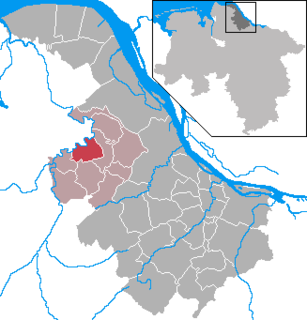Wilhelmshaven is a coastal town in Lower Saxony, Germany. It is situated on the western side of the Jade Bight, a bay of the North Sea, and has a population of 76,089. Wilhelmshaven is the centre of the "JadeBay" business region and is Germany's main military port.

Wolfenbüttel is a town in Lower Saxony, Germany, the administrative capital of Wolfenbüttel District. It is best known as the location of the internationally renowned Herzog August Library and for having the largest concentration of timber-framed buildings in Germany. It is an episcopal see of the Evangelical Lutheran Church in Brunswick. It is also home to the Jägermeister distillery, houses a campus of the Ostfalia University of Applied Sciences, and the Landesmusikakademie of Lower Saxony.

Osterholz-Scharmbeck is a town and the capital of the district of Osterholz, in Lower Saxony, Germany. Osterholz-Scharmbeck is situated in between the cities of Bremen and Bremerhaven.

Lingen, officially Lingen (Ems), is a town in Lower Saxony, Germany. In 2008, its population was 52,353, and in addition there were about 5,000 people who registered the city as their secondary residence. Lingen, specifically "Lingen (Ems)" is located on the river Ems in the southern part of the Emsland District, which borders North Rhine-Westphalia in the south and the Netherlands in the west.

Butjadingen is a peninsula and municipality in the Wesermarsch district, in Lower Saxony, Germany.

Bremervörde is a town in the north of the district (Landkreis) of Rotenburg, in Lower Saxony, Germany. It is situated on the Oste river near the centre of the "triangle" formed by the rivers Weser and Elbe, roughly equidistant from the cities of Hamburg, Bremen and Cuxhaven.

Papenburg is a city in the district of Emsland, Lower Saxony, Germany, situated at the river Ems. It is known for its large shipyard, the Meyer-Werft, which specializes in building cruise liners.

Rastede is a municipality in the Ammerland district, in Lower Saxony, Germany. It is situated approximately 12 km north of Oldenburg. It is the site of the Schloss Rastede.

Faßberg is a municipality in the district of Celle, in Lower Saxony, Germany. It is situated approximately 35 km north of Celle, and 30 km west of Uelzen.

Bockhorn is a municipality in the district of Friesland, in Lower Saxony, Germany. It is approximately 15 km southwest of Wilhelmshaven, and 30 km northwest of Oldenburg.

Langelsheim is a town in the district of Goslar in Lower Saxony, Germany.

Winsen (Luhe) is the capital of the district of Harburg, in Lower Saxony, Germany. It is situated on the small river Luhe, near its confluence with the Elbe, approx. 25 km southeast of Hamburg, and 20 km northwest of Lüneburg.

Lüchow (Wendland) is a city in northeastern Lower Saxony, in Germany. It is the seat of the Samtgemeinde Lüchow (Wendland), and is the capital of the district Lüchow-Dannenberg. Situated approximately 13 km north of Salzwedel, Lüchow is located on the German Framework Road. In the Polabian language, Lüchow is called Ljauchüw.

Dissen am Teutoburger Wald is an old charactered town in the district of Osnabrück, in Lower Saxony, Germany. It is situated in the Teutoburg Forest, approximately 20 km southeast of Osnabrück.

Lehrte is a town in the district of Hanover, in Lower Saxony, Germany. It is situated approximately 17 km east of Hanover. In the 19th century Lehrte was the most important railway junction in the former Kingdom of Hanover. As of the 21st century, it has a population of 43,000.

Lichtenberg is a town in northeastern Bavaria, lying in the district of Hof in Upper Franconia.

Mittelstenahe is a municipality in the district of Cuxhaven, in Lower Saxony, Germany.

Burweg is a municipality in the district of Stade, Lower Saxony, Germany.

Engelschoff is a municipality in the district of Stade, Lower Saxony, Germany.

Großenwörden is a municipality in the district of Stade, Lower Saxony, Germany.

























